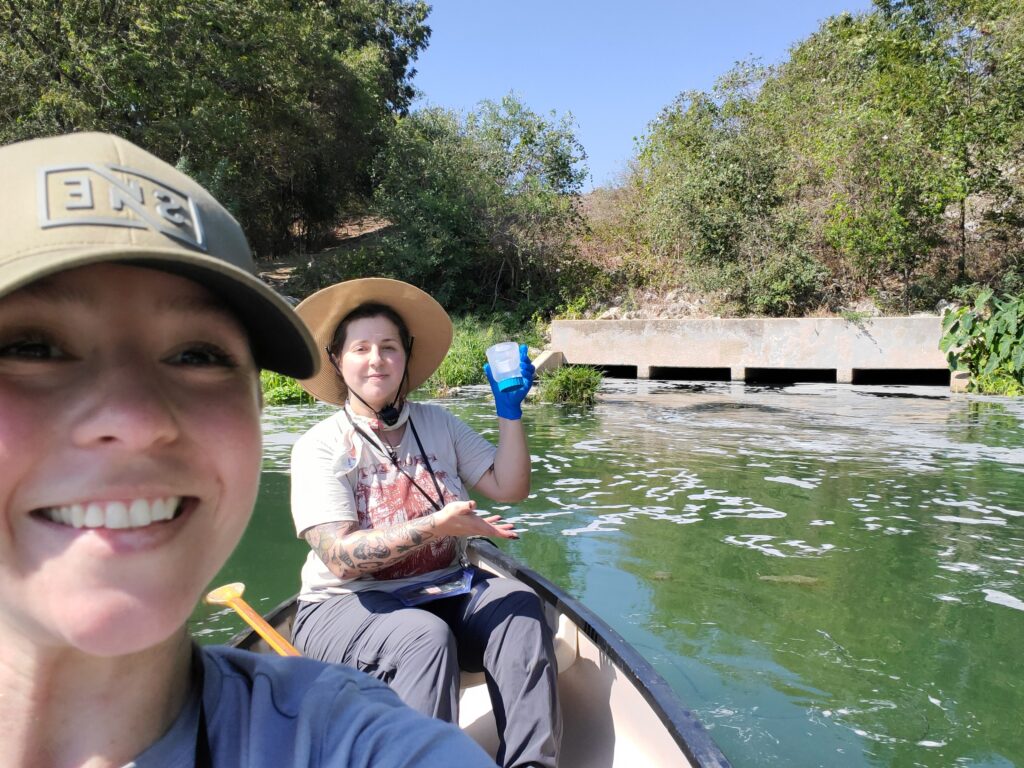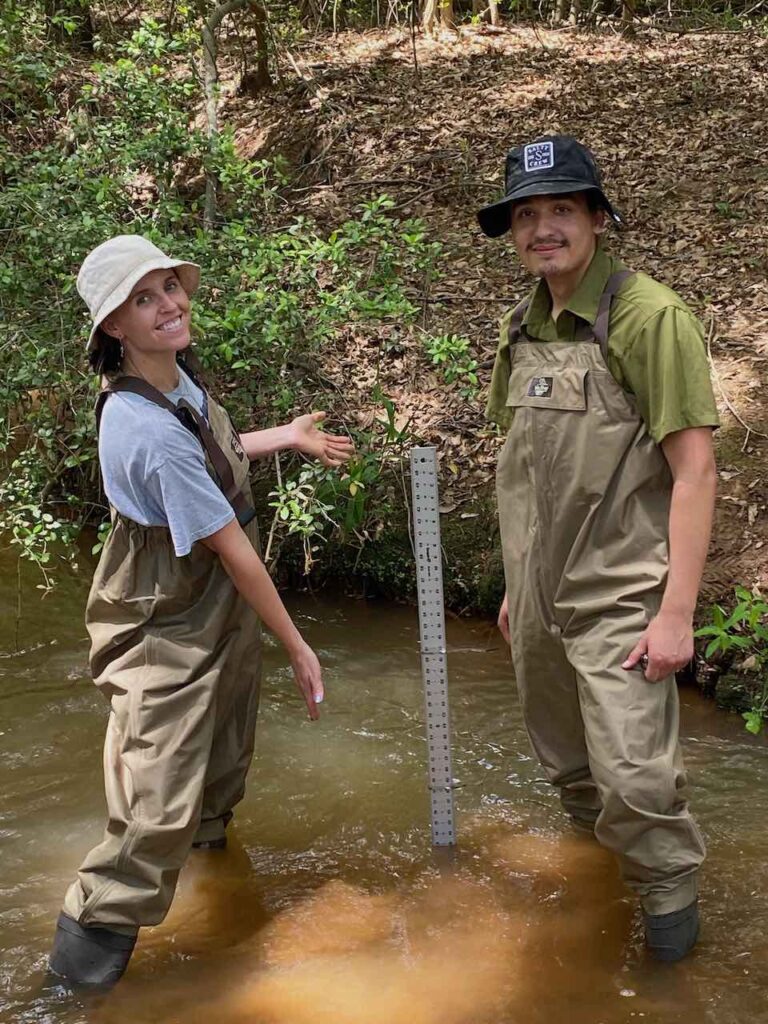Bringing Science to Decision-Making
Updated June 14, 2024
After many years of urging government entities to recognize and monitor the impacts of groundwater pumping on surface waters, Environmental Stewardship has launched a water monitoring project in Bastrop and Lee counties, Texas, to get the work started and to inform decisions in the region. Having participated as a stakeholder in groundwater and surface water management programs at the state and local levels, where Environmental Stewardship provided the science to demonstrate the potential impacts on the Colorado River predicted by the model, the only ingredient lacking to convince decision-makers of the need to take regulatory action, is field data. Though the models are informed by the best available science, planners and regulators are not confident enough to take action solely based on modeled predictions.
As such, Environmental Stewardship is stepping in to initiate this process by filling the gap on a local basis. We invite planners and regulators to join us in the task of setting up the projects and programs needed to collect, analyze, and use field data to inform vitally important decisions that will impact our immediate future, and the future of generations that will follow. To do this, we have purchased state-of-the-art scientific instruments to measure water flow, water chemistry, and well water depth. And we have equipped a mobile laboratory to start collecting data on the current status of surface water-groundwater interaction. This scientific field data will be provided to decision-makers and the public so that inform decision can be made regarding sustainable management of the natural waters in our region.
Water Monitoring Project Update & Wilbarger Bend Study Site
June 14, 2024. UPDATE
 Over the last two years Environmental Stewardship has engaged interns and personnel and outfitted and equipped a water monitoring trailer to serve as a local water monitoring team to investigate and document surface water-groundwater interactions in Bastrop and Lee Counties, Texas. The project serves to advance our founding mission to protect, conserve, restore, and enhance the earth’s natural resources in order to meet current and future needs of the environment and humans by gathering and using scientific information to restore and sustain ecological services provided by environmental systems. The information derived from the project serves to bring science to decision-makers and environmental outreach and education to the public thereby encouraging good public stewardship. As such, the Water Monitoring Project per se, falls under Environmental Stewardship’s Science and Ecology purpose and informs its Public Policy, Outreach, and Education purposes.
Over the last two years Environmental Stewardship has engaged interns and personnel and outfitted and equipped a water monitoring trailer to serve as a local water monitoring team to investigate and document surface water-groundwater interactions in Bastrop and Lee Counties, Texas. The project serves to advance our founding mission to protect, conserve, restore, and enhance the earth’s natural resources in order to meet current and future needs of the environment and humans by gathering and using scientific information to restore and sustain ecological services provided by environmental systems. The information derived from the project serves to bring science to decision-makers and environmental outreach and education to the public thereby encouraging good public stewardship. As such, the Water Monitoring Project per se, falls under Environmental Stewardship’s Science and Ecology purpose and informs its Public Policy, Outreach, and Education purposes.
The territorial scope of the project serves to enhance the existing, but disconnected monitoring programs in Central Texas where separate programs are operated by the Texas Commission on Environmental Quality (TCEQ) for surface waters within defined river basins, and local groundwater conservation districts, such as the Lost Pines Groundwater Conservation District (LPGCD) for groundwater with county jurisdictions. Neither of these two programs coordinate nor share efforts and data in a way that is aimed at conjunctively protecting, conserving, understanding, and beneficially using the surface and groundwater under their overlapping jurisdictions. To that end, it is necessary that the territorial scope of this project be broad enough to include the groundwaters that are under the jurisdiction of the LPGCD and the portions of the river basins that interact with these groundwaters in the Lower Colorado River Basin (Basin 14) under the jurisdiction of the Lower Colorado River Authority, and the Brazos River Basin (Basin 12) under the jurisdiction of the Brazos River Authority. It is anticipated that interaction between these stakeholder entities will evolve more-or-less organically as this project unfolds.
The water monitoring program is based on measuring stream flow and water chemistry in rivers, streams and domestic wells in areas where groundwater discharge is thought to occur or is otherwise relevant to the conservation and protection of these precious resources. Data sets of well, spring, and stream water quality data are used to determine if it is likely that the stream water and well water come from the same aquifer source, and at what rate the groundwater is being discharged to the stream. These data sets will be used to inform the groundwater availability model (GAM) to populate specific cells with surface water-groundwater interaction data. The well depth data will be used to monitor the water level in the Colorado River Alluvium (Colorado Alluvial Aquifer) to determine whether the river is being managed in a way that will maintain a gaining relationship through a repeat of the Drought of Record (2010-2015).
Wilbarger Bend Study Site: Field studies conducted by Environmental Stewardship on December 11, 2023, indicate that there is a potential that the Simsboro and Hooper aquifers contribute groundwater to the Colorado River along the contours of the lower end of the Wilbarger Bend peninsula. Chemical and physical data collected showed that three parameters changed statistically between the first half and the last half of the of the river bend. A gain-loss study, along with chemical comparisons between the river and aquifers, are needed to conclude that these aquifers communicate with the river and river alluvial aquifer in this reach of the river.
If true that these Wilcox aquifer formations exchange water with the river at this location, it becomes incumbent on decision makers to follow the interest of recommendations of the Central Texas Greenprint for Growth to designate the Wilbarger Bend as a high priority sensitive ecological area, and a high priority water quality and quantity region. Under such a designation and considering the concerns regarding contamination of the aquifers that serve as drinking-water sources for the City of Bastrop and Aqua Water Supply Corporation service territory, monitoring of the surface water-groundwater interaction in the Bend will be a high priority.
To that end, Environmental Stewardship intends to declare the Wilbarger Bend as a high priority water monitoring study site and initiate field studies to confirm whether this reach of the river is a location for major surface water-groundwater interaction, and the current status of the Colorado Alluvial Aquifer.
To read more click the link: Water Monitoring Project Update. To read more about the Wilbarger Bend Demonstration and Study Site see APPENDIX 2 in the previous document.
First Demonstration Project – Presidio Lake Study Site

University of Texas interns Molly Fisher and Darrell Hall taking reading on the FlowTracker stream flow instrument.
On April 23, 2022, Environmental Stewardship, assisted by interns from one of our collaborators, Green Gate Farms‘ University of Texas intern program, held its first water monitoring event at Presidio Lake Study Site in Lee County, Texas. Presidio Lake is a spring fed reservoir that, according to the landowner and lore, has not stopped flowing for over 100 years … until recently. Two study sites (PLSS-1 and PLSS-2) were established by taking stream flow rate measurements using a state-of-the-art SonTek Flow Tracker 2 instrument. From those two measurements, the study team was able to document that the flow of the Owens Branch of Middle Yegua Creek into- and out-of the lake were 1.3470 and 1.4272 cubic feet per second respectively. Not only were initial flow rates taken to document the current status of the surface water flow, but, in conjunction with geological maps and stratigraphic information, the team was able to make a hypothesis (scientific proposition) about the potential source(s) of the water. Subsequent field data collection will further document the flow, quantify the water chemistry, and test the hypothesis to determine if the source of the water is groundwater, and, if so, what aquifer(s) it is likely derived from.
As the project expands throughout the counties, the use of T-post monitoring gauges will greatly enhance the ability to collect stream flow data. Calibrated aluminum “yard sticks” attached to a t-posts imbedded in the stream will allow landowners to monitor changes in stream flow by making and recording observed water depth when there are observable changes in stream flow (up or down). Stream flow rate (cfs, or cubic feet per second) will be associated with depth measurements over time to provide a “rate curve” for each gauge station, thus providing a method for extrapolating stream flow rate from the calibrated depth measurements. We will solicit landowner participation in this part of the program when we have the primary program up and running and have determined which creeks, streams, springs and/or seeps we need to focus on. For now, there is an urgent issue in eastern Lee County due to the Vista Ridge groundwater pumping just across the line in Burleson County.
With monitoring gauges in streams throughout the counties a great deal of field data can be collected while optimizing use of the FlowTracker instrument. For example, the gauge in the photograph on the left is calibrated to be 1.34 cfs (cubic feet per second) at a stream depth of 13 inches. That is a flow rate of about 600 gallons per minute, which is the rate the landowner confirmed had been estimated by others, further confirming the validity of the measurement. A flow rate of 1.34 cfs is equivalent to 316,113,588 gallons per year, or 970 acre feet per year of water. If this flow is essentially all from groundwater discharging into the stream, it is a significant contribution to the flow of Owens Branch and Middle Yegua Creeks, tributaries to the Brazos River. This is a flowrate that would be very significant in maintaining the ecology of Presidio Lake and the region during drought conditions. Loss of this discharge from groundwater due to non-exempt pumping would be considered an unreasonable impact on surface waters, the environment, the landowners, and the communities that depend on such outflows.
PFAS Compounds found throughout the Austin to Smithville
Segment of the Colorado River and its tributaries.
As a result of samples taken by Environmental Stewardship in cooperation with Waterkeeper Alliance — where we found Per- and Poly-Fluoroamine Substances (PFAS) in the river — we have launched a major monitoring program to identify and quantify these compounds in the Austin-Bastrop-Smithville corridor. To date we have mapped where these “forever chemical” compounds are found in the Colorado River basin between Austin and Smithville, Texas. We have sampled more than 35 river, tributary, alluvial aquifer, and groundwater well locations. Click here for more information on the PFAS Sampling Project.
This is clearly a work in progress!
We still have work to do to finish outfitting the trailer so that it is serviceable as a mobile laboratory, preparing an Operations Manual to guide the use of the trailer and equipment, recruiting and training monitoring specialists to use the instruments and equipment , and a list of other work needed to get the project off-the-ground and running. And importantly, we are also in need of donations to help fund an internship/monitoring specialist program to support the field work. If you have an interest in helping with these projects, please contact us so we can discuss how you can help.



